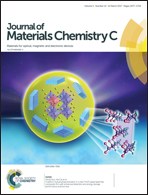Prediction of tunable quantum spin Hall effect in methyl-functionalized tin film
Abstract
The quantum spin Hall (QSH) effect may promote revolutionary device development due to dissipationless propagation of spin currents. The bottleneck preventing applications from the QSH effect, however, is a lack of large nontrivial bulk gap and highly stable two-dimensional (2D) films. In this work, we design a novel 2D honeycomb lattice, namely a SnCH3 monolayer, using comprehensive density-functional theory (DFT) computations. The structural stability is confirmed using a phonon spectrum and molecular dynamics simulations. Interestingly, its nontrivial bulk gap can reach up to 0.34 eV, which is further tunable via external strain. The nontrivial topology stems mainly from band inversion between the s–px,y orbitals, demonstrated by the nonzero topological invariant Z2 and a single pair of gapless helical edge states located in the bulk gap. The effects of a growth substrate on the QSH effect are also checked by hydrogen bonding on a single side in stanene, showing the robustness of the observed QSH phase. Considering its compatibility with the current electronics industry, these findings present an efficient platform to enrich topological phenomena and expand potential applications of 2D stanene at high temperature.



 Please wait while we load your content...
Please wait while we load your content...